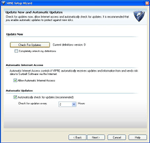Vipre Antivirus has a great combination of feature, and though the company is relatively new on the security screne, their antivirus software is one of the best. It's not a typo, 'VIPRE' stand for Virus Intrusion Prevention Remediation Engine. The software includes antivirus and antispyware protection, as well as a number of additional compelling features.
Probably the most unique offering from Vipre is their unlimited home site license option. With the unlimited license you can run the software on as many computers (as well as laptops and netbooks) that you have at home. For families with three or more PCs, this is a very affordable option.
Despite still being relatively new in the competitive field of antivirus software, VIPRE AntiVirus + AntiSpyware comes out swinging this year with what PC antivirus review team of reviewers found to be the best, lightest-running antivirus software for 2010.
The balancing act with antivirus and anti-spyware is managing to be light-running while still providing PC protection. This is one place where VIPRE delivers on its promise better than any of its competitors.
The team testing consistently showed VIPRE to be among the best performing software in every test they ran. In fact, some of the older better known antivirus programs like McAfee and Norton didn't do nearly as well as VIPRE this year.
In comparison, VIPRE's light resource usage, strong antivirus and antispyware protection, and excellent customer service consistently pushed it to the front of the pack. Installation is a snap. The user interface is clean and easy-to-use. Email protection is reliable and solid.
Overall virus, spyware, and malware protection is equal to or better than we've seen in most any antivirus software--especially from software that's a relative newcomer compared to the household names like McAfee, Norton, and Kaspersky.
Antivirus Installation: 100%
VIPRE Antivirus installation is easy and straight forward. Just download and run the initial installer which sets up the files you need for installation. you will need to reboot your PC at this point. After the installation, a wizard runs to configure your initial options. These are for things like:
- definition update frequency
- internet access settings
- registration options
At the end of this wizard you'll find a link that launches a video which describes the software and some basic usage.Even if you're a seasoned computer professional, you'll be well-served watching the video. It's well done and may introduce you to some features in VIPRE you're unaware of.
Installation only took about 1 minute, and total time from download through reboot was about 6 minutes.
User Interface: 98%
The user interface (UI) is very good looking with easy-to-use navigation. The background color is muted, and alerts are color-coded green or red when they need attentionm making it easy to see what's important.VIPRE marks the appropriate settings by default for the novice user, but more advanced users can click an "Advanced" link that allows you to adjust more detailed settings. In our opinion, the default settings should be adequate for most users.
Each tab has a help button that opens to the appropriate page in the help file where you'll also find a complete, indexed help section.
Real-time Protection: 93%
VIPRE detected 90% of the viruses and other malware during our real-time protection tests - a superb score considering no antivirus software can ever be 100% perfect. The only files VIPRE didn't initially identify were all quickly captured and removed when the viruses actually tried to run. Thus effectively making the viruses and malware useless. Once a virus tries to do something nasty, even if VIPRE didn't initially detect it, VIPRE's real-time engine kicks in and stops the whatever the virus is trying to do.VIPRE is known for its fast scanning and response time, all while keeping a low resource footprint. When real-time protection was enabled on computers in the test lab, only about 65MB of memory was used.
Resource Usage: 95%
Real-time resource usage was the lowest of all the antivirus software we tested, using only about 0.5% of memory. A full-system, manual scan peaked occasionally at 50% - 60% CPU usage, then dipped back down as it moved to different parts of the antivirus scan. Only about 60MB of memory was used during a manual scan.Very good, especially compared to some of VIPRE's heavier competitors.
VIPRE used only 0.5% memory during real-time protection.
VIPRE used only 60MB of memory during a manual scan.
VIPRE used only 60% of CPU during a manual scan.
































